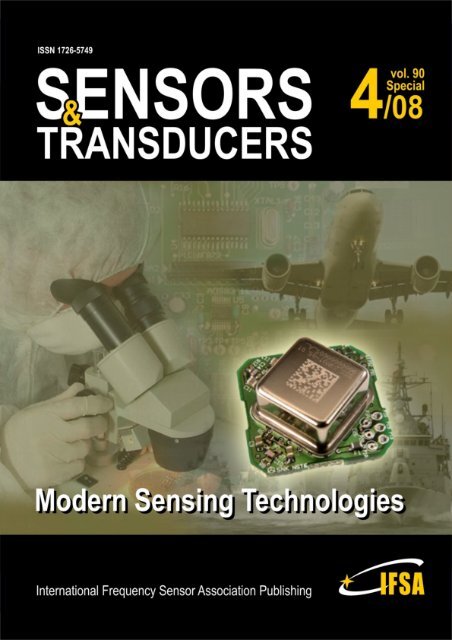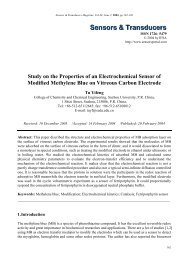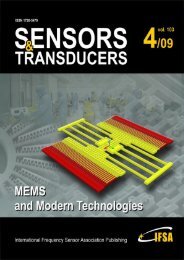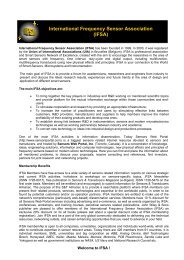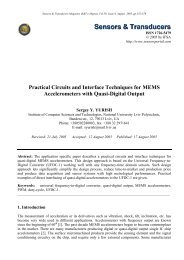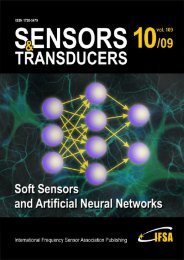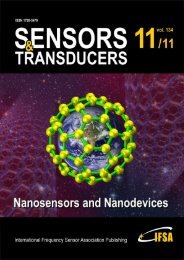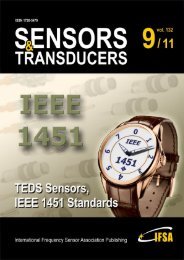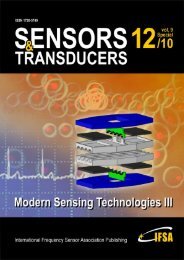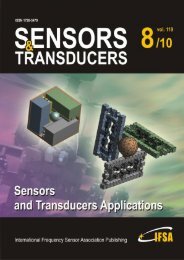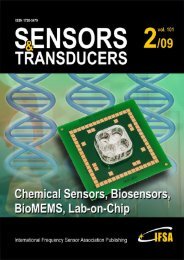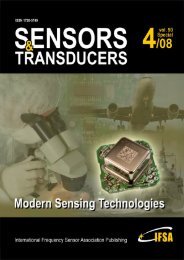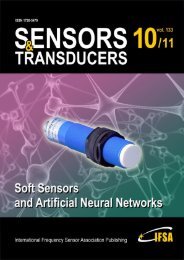A Portable Nuclear Magnetic Resonance Sensor System
A Portable Nuclear Magnetic Resonance Sensor System
A Portable Nuclear Magnetic Resonance Sensor System
You also want an ePaper? Increase the reach of your titles
YUMPU automatically turns print PDFs into web optimized ePapers that Google loves.
<strong>Sensor</strong>s & Transducers<br />
Special Issue<br />
April 2008<br />
www.sensorsportal.com ISSN 1726-5479<br />
Editor-in-Chief: Sergey Y. Yurish<br />
Guest Editors: Subhas Chandra Mukhopadhyay and Gourab Sen Gupta<br />
Editors for Western Europe<br />
Meijer, Gerard C.M., Delft University of Technology, The Netherlands<br />
Ferrari, Vittorio, Universitá di Brescia, Italy<br />
Editors for North America<br />
Datskos, Panos G., Oak Ridge National Laboratory, USA<br />
Fabien, J. Josse, Marquette University, USA<br />
Katz, Evgeny, Clarkson University, USA<br />
Editor South America<br />
Costa-Felix, Rodrigo, Inmetro, Brazil<br />
Editor for Eastern Europe<br />
Sachenko, Anatoly, Ternopil State Economic University, Ukraine<br />
Editor for Asia<br />
Ohyama, Shinji, Tokyo Institute of Technology, Japan<br />
Editorial Advisory Board<br />
Abdul Rahim, Ruzairi, Universiti Teknologi, Malaysia<br />
Ahmad, Mohd Noor, Nothern University of Engineering, Malaysia<br />
Annamalai, Karthigeyan, National Institute of Advanced Industrial Science and<br />
Technology, Japan<br />
Arcega, Francisco, University of Zaragoza, Spain<br />
Arguel, Philippe, CNRS, France<br />
Ahn, Jae-Pyoung, Korea Institute of Science and Technology, Korea<br />
Arndt, Michael, Robert Bosch GmbH, Germany<br />
Ascoli, Giorgio, George Mason University, USA<br />
Atalay, Selcuk, Inonu University, Turkey<br />
Atghiaee, Ahmad, University of Tehran, Iran<br />
Augutis, Vygantas, Kaunas University of Technology, Lithuania<br />
Avachit, Patil Lalchand, North Maharashtra University, India<br />
Ayesh, Aladdin, De Montfort University, UK<br />
Bahreyni, Behraad, University of Manitoba, Canada<br />
Baoxian, Ye, Zhengzhou University, China<br />
Barford, Lee, Agilent Laboratories, USA<br />
Barlingay, Ravindra, RF Arrays <strong>System</strong>s, India<br />
Basu, Sukumar, Jadavpur University, India<br />
Beck, Stephen, University of Sheffield, UK<br />
Ben Bouzid, Sihem, Institut National de Recherche Scientifique, Tunisia<br />
Binnie, T. David, Napier University, UK<br />
Bischoff, Gerlinde, Inst. Analytical Chemistry, Germany<br />
Bodas, Dhananjay, IMTEK, Germany<br />
Borges Carval, Nuno, Universidade de Aveiro, Portugal<br />
Bousbia-Salah, Mounir, University of Annaba, Algeria<br />
Bouvet, Marcel, CNRS – UPMC, France<br />
Brudzewski, Kazimierz, Warsaw University of Technology, Poland<br />
Cai, Chenxin, Nanjing Normal University, China<br />
Cai, Qingyun, Hunan University, China<br />
Campanella, Luigi, University La Sapienza, Italy<br />
Carvalho, Vitor, Minho University, Portugal<br />
Cecelja, Franjo, Brunel University, London, UK<br />
Cerda Belmonte, Judith, Imperial College London, UK<br />
Chakrabarty, Chandan Kumar, Universiti Tenaga Nasional, Malaysia<br />
Chakravorty, Dipankar, Association for the Cultivation of Science, India<br />
Changhai, Ru, Harbin Engineering University, China<br />
Chaudhari, Gajanan, Shri Shivaji Science College, India<br />
Chen, Jiming, Zhejiang University, China<br />
Chen, Rongshun, National Tsing Hua University, Taiwan<br />
Cheng, Kuo-Sheng, National Cheng Kung University, Taiwan<br />
Chiriac, Horia, National Institute of Research and Development, Romania<br />
Chowdhuri, Arijit, University of Delhi, India<br />
Chung, Wen-Yaw, Chung Yuan Christian University, Taiwan<br />
Corres, Jesus, Universidad Publica de Navarra, Spain<br />
Cortes, Camilo A., Universidad Nacional de Colombia, Colombia<br />
Courtois, Christian, Universite de Valenciennes, France<br />
Cusano, Andrea, University of Sannio, Italy<br />
D'Amico, Arnaldo, Università di Tor Vergata, Italy<br />
De Stefano, Luca, Institute for Microelectronics and Microsystem, Italy<br />
Deshmukh, Kiran, Shri Shivaji Mahavidyalaya, Barshi, India<br />
Kang, Moonho, Sunmoon University, Korea South<br />
Kaniusas, Eugenijus, Vienna University of Technology, Austria<br />
Katake, Anup, Texas A&M University, USA<br />
Kausel, Wilfried, University of Music, Vienna, Austria<br />
Dickert, Franz L., Vienna University, Austria<br />
Dieguez, Angel, University of Barcelona, Spain<br />
Dimitropoulos, Panos, University of Thessaly, Greece<br />
Ding Jian, Ning, Jiangsu University, China<br />
Djordjevich, Alexandar, City University of Hong Kong, Hong Kong<br />
Donato, Nicola, University of Messina, Italy<br />
Donato, Patricio, Universidad de Mar del Plata, Argentina<br />
Dong, Feng, Tianjin University, China<br />
Drljaca, Predrag, Instersema <strong>Sensor</strong>ic SA, Switzerland<br />
Dubey, Venketesh, Bournemouth University, UK<br />
Enderle, Stefan, University of Ulm and KTB Mechatronics GmbH, Germany<br />
Erdem, Gursan K. Arzum, Ege University, Turkey<br />
Erkmen, Aydan M., Middle East Technical University, Turkey<br />
Estelle, Patrice, Insa Rennes, France<br />
Estrada, Horacio, University of North Carolina, USA<br />
Faiz, Adil, INSA Lyon, France<br />
Fericean, Sorin, Balluff GmbH, Germany<br />
Fernandes, Joana M., University of Porto, Portugal<br />
Francioso, Luca, CNR-IMM Institute for Microelectronics and Microsystems,<br />
Italy<br />
Francis, Laurent, University Catholique de Louvain, Belgium<br />
Fu, Weiling, South-Western Hospital, Chongqing, China<br />
Gaura, Elena, Coventry University, UK<br />
Geng, Yanfeng, China University of Petroleum, China<br />
Gole, James, Georgia Institute of Technology, USA<br />
Gong, Hao, National University of Singapore, Singapore<br />
Gonzalez de la Rosa, Juan Jose, University of Cadiz, Spain<br />
Granel, Annette, Goteborg University, Sweden<br />
Graff, Mason, The University of Texas at Arlington, USA<br />
Guan, Shan, Eastman Kodak, USA<br />
Guillet, Bruno, University of Caen, France<br />
Guo, Zhen, New Jersey Institute of Technology, USA<br />
Gupta, Narendra Kumar, Napier University, UK<br />
Hadjiloucas, Sillas, The University of Reading, UK<br />
Hashsham, Syed, Michigan State University, USA<br />
Hernandez, Alvaro, University of Alcala, Spain<br />
Hernandez, Wilmar, Universidad Politecnica de Madrid, Spain<br />
Homentcovschi, Dorel, SUNY Binghamton, USA<br />
Horstman, Tom, U.S. Automation Group, LLC, USA<br />
Hsiai, Tzung (John), University of Southern California, USA<br />
Huang, Jeng-Sheng, Chung Yuan Christian University, Taiwan<br />
Huang, Star, National Tsing Hua University, Taiwan<br />
Huang, Wei, PSG Design Center, USA<br />
Hui, David, University of New Orleans, USA<br />
Jaffrezic-Renault, Nicole, Ecole Centrale de Lyon, France<br />
Jaime Calvo-Galleg, Jaime, Universidad de Salamanca, Spain<br />
James, Daniel, Griffith University, Australia<br />
Janting, Jakob, DELTA Danish Electronics, Denmark<br />
Jiang, Liudi, University of Southampton, UK<br />
Jiao, Zheng, Shanghai University, China<br />
John, Joachim, IMEC, Belgium<br />
Kalach, Andrew, Voronezh Institute of Ministry of Interior, Russia<br />
Rodriguez, Angel, Universidad Politecnica de Cataluna, Spain<br />
Rothberg, Steve, Loughborough University, UK<br />
Sadana, Ajit, University of Mississippi, USA
Kavasoglu, Nese, Mugla University, Turkey<br />
Ke, Cathy, Tyndall National Institute, Ireland<br />
Khan, Asif, Aligarh Muslim University, Aligarh, India<br />
Kim, Min Young, Koh Young Technology, Inc., Korea South<br />
Ko, Sang Choon, Electronics and Telecommunications Research Institute, Korea<br />
South<br />
Kockar, Hakan, Balikesir University, Turkey<br />
Kotulska, Malgorzata, Wroclaw University of Technology, Poland<br />
Kratz, Henrik, Uppsala University, Sweden<br />
Kumar, Arun, University of South Florida, USA<br />
Kumar, Subodh, National Physical Laboratory, India<br />
Kung, Chih-Hsien, Chang-Jung Christian University, Taiwan<br />
Lacnjevac, Caslav, University of Belgrade, Serbia<br />
Lay-Ekuakille, Aime, University of Lecce, Italy<br />
Lee, Jang Myung, Pusan National University, Korea South<br />
Lee, Jun Su, Amkor Technology, Inc. South Korea<br />
Lei, Hua, National Starch and Chemical Company, USA<br />
Li, Genxi, Nanjing University, China<br />
Li, Hui, Shanghai Jiaotong University, China<br />
Li, Xian-Fang, Central South University, China<br />
Liang, Yuanchang, University of Washington, USA<br />
Liawruangrath, Saisunee, Chiang Mai University, Thailand<br />
Liew, Kim Meow, City University of Hong Kong, Hong Kong<br />
Lin, Hermann, National Kaohsiung University, Taiwan<br />
Lin, Paul, Cleveland State University, USA<br />
Linderholm, Pontus, EPFL - Microsystems Laboratory, Switzerland<br />
Liu, Aihua, University of Oklahoma, USA<br />
Liu Changgeng, Louisiana State University, USA<br />
Liu, Cheng-Hsien, National Tsing Hua University, Taiwan<br />
Liu, Songqin, Southeast University, China<br />
Lodeiro, Carlos, Universidade NOVA de Lisboa, Portugal<br />
Lorenzo, Maria Encarnacio, Universidad Autonoma de Madrid, Spain<br />
Lukaszewicz, Jerzy Pawel, Nicholas Copernicus University, Poland<br />
Ma, Zhanfang, Northeast Normal University, China<br />
Majstorovic, Vidosav, University of Belgrade, Serbia<br />
Marquez, Alfredo, Centro de Investigacion en Materiales Avanzados, Mexico<br />
Matay, Ladislav, Slovak Academy of Sciences, Slovakia<br />
Mathur, Prafull, National Physical Laboratory, India<br />
Maurya, D.K., Institute of Materials Research and Engineering, Singapore<br />
Mekid, Samir, University of Manchester, UK<br />
Melnyk, Ivan, Photon Control Inc., Canada<br />
Mendes, Paulo, University of Minho, Portugal<br />
Mennell, Julie, Northumbria University, UK<br />
Mi, Bin, Boston Scientific Corporation, USA<br />
Minas, Graca, University of Minho, Portugal<br />
Moghavvemi, Mahmoud, University of Malaya, Malaysia<br />
Mohammadi, Mohammad-Reza, University of Cambridge, UK<br />
Molina Flores, Esteban, Benemérita Universidad Autónoma de Puebla, Mexico<br />
Moradi, Majid, University of Kerman, Iran<br />
Morello, Rosario, DIMET, University "Mediterranea" of Reggio Calabria, Italy<br />
Mounir, Ben Ali, University of Sousse, Tunisia<br />
Mukhopadhyay, Subhas, Massey University, New Zealand<br />
Neelamegam, Periasamy, Sastra Deemed University, India<br />
Neshkova, Milka, Bulgarian Academy of Sciences, Bulgaria<br />
Oberhammer, Joachim, Royal Institute of Technology, Sweden<br />
Ould Lahoucin, University of Guelma, Algeria<br />
Pamidighanta, Sayanu, Bharat Electronics Limited (BEL), India<br />
Pan, Jisheng, Institute of Materials Research & Engineering, Singapore<br />
Park, Joon-Shik, Korea Electronics Technology Institute, Korea South<br />
Penza, Michele, ENEA C.R., Italy<br />
Pereira, Jose Miguel, Instituto Politecnico de Setebal, Portugal<br />
Petsev, Dimiter, University of New Mexico, USA<br />
Pogacnik, Lea, University of Ljubljana, Slovenia<br />
Post, Michael, National Research Council, Canada<br />
Prance, Robert, University of Sussex, UK<br />
Prasad, Ambika, Gulbarga University, India<br />
Prateepasen, Asa, Kingmoungut's University of Technology, Thailand<br />
Pullini, Daniele, Centro Ricerche FIAT, Italy<br />
Pumera, Martin, National Institute for Materials Science, Japan<br />
Radhakrishnan, S. National Chemical Laboratory, Pune, India<br />
Rajanna, K., Indian Institute of Science, India<br />
Ramadan, Qasem, Institute of Microelectronics, Singapore<br />
Rao, Basuthkar, Tata Inst. of Fundamental Research, India<br />
Raoof, Kosai, Joseph Fourier University of Grenoble, France<br />
Reig, Candid, University of Valencia, Spain<br />
Restivo, Maria Teresa, University of Porto, Portugal<br />
Robert, Michel, University Henri Poincare, France<br />
Rezazadeh, Ghader, Urmia University, Iran<br />
Royo, Santiago, Universitat Politecnica de Catalunya, Spain<br />
Sadeghian Marnani, Hamed, TU Delft, The Netherlands<br />
Sandacci, Serghei, <strong>Sensor</strong> Technology Ltd., UK<br />
Sapozhnikova, Ksenia, D.I.Mendeleyev Institute for Metrology, Russia<br />
Saxena, Vibha, Bhbha Atomic Research Centre, Mumbai, India<br />
Schneider, John K., Ultra-Scan Corporation, USA<br />
Seif, Selemani, Alabama A & M University, USA<br />
Seifter, Achim, Los Alamos National Laboratory, USA<br />
Sengupta, Deepak, Advance Bio-Photonics, India<br />
Shearwood, Christopher, Nanyang Technological University, Singapore<br />
Shin, Kyuho, Samsung Advanced Institute of Technology, Korea<br />
Shmaliy, Yuriy, Kharkiv National University of Radio Electronics, Ukraine<br />
Silva Girao, Pedro, Technical University of Lisbon, Portugal<br />
Singh, V. R., National Physical Laboratory, India<br />
Slomovitz, Daniel, UTE, Uruguay<br />
Smith, Martin, Open University, UK<br />
Soleymanpour, Ahmad, Damghan Basic Science University, Iran<br />
Somani, Prakash R., Centre for Materials for Electronics Technol., India<br />
Srinivas, Talabattula, Indian Institute of Science, Bangalore, India<br />
Srivastava, Arvind K., Northwestern University, USA<br />
Stefan-van Staden, Raluca-Ioana, University of Pretoria, South Africa<br />
Sumriddetchka, Sarun, National Electronics and Computer Technology Center,<br />
Thailand<br />
Sun, Chengliang, Polytechnic University, Hong-Kong<br />
Sun, Dongming, Jilin University, China<br />
Sun, Junhua, Beijing University of Aeronautics and Astronautics, China<br />
Sun, Zhiqiang, Central South University, China<br />
Suri, C. Raman, Institute of Microbial Technology, India<br />
Sysoev, Victor, Saratov State Technical University, Russia<br />
Szewczyk, Roman, Industrial Research Institute for Automation and Measurement,<br />
Poland<br />
Tan, Ooi Kiang, Nanyang Technological University, Singapore,<br />
Tang, Dianping, Southwest University, China<br />
Tang, Jaw-Luen, National Chung Cheng University, Taiwan<br />
Teker, Kasif, Frostburg State University, USA<br />
Thumbavanam Pad, Kartik, Carnegie Mellon University, USA<br />
Tian, Gui Yun, University of Newcastle, UK<br />
Tsiantos, Vassilios, Technological Educational Institute of Kaval, Greece<br />
Tsigara, Anna, National Hellenic Research Foundation, Greece<br />
Twomey, Karen, University College Cork, Ireland<br />
Valente, Antonio, University, Vila Real, - U.T.A.D., Portugal<br />
Vaseashta, Ashok, Marshall University, USA<br />
Vazques, Carmen, Carlos III University in Madrid, Spain<br />
Vieira, Manuela, Instituto Superior de Engenharia de Lisboa, Portugal<br />
Vigna, Benedetto, STMicroelectronics, Italy<br />
Vrba, Radimir, Brno University of Technology, Czech Republic<br />
Wandelt, Barbara, Technical University of Lodz, Poland<br />
Wang, Jiangping, Xi'an Shiyou University, China<br />
Wang, Kedong, Beihang University, China<br />
Wang, Liang, Advanced Micro Devices, USA<br />
Wang, Mi, University of Leeds, UK<br />
Wang, Shinn-Fwu, Ching Yun University, Taiwan<br />
Wang, Wei-Chih, University of Washington, USA<br />
Wang, Wensheng, University of Pennsylvania, USA<br />
Watson, Steven, Center for NanoSpace Technologies Inc., USA<br />
Weiping, Yan, Dalian University of Technology, China<br />
Wells, Stephen, Southern Company Services, USA<br />
Wolkenberg, Andrzej, Institute of Electron Technology, Poland<br />
Woods, R. Clive, Louisiana State University, USA<br />
Wu, DerHo, National Pingtung University of Science and Technology, Taiwan<br />
Wu, Zhaoyang, Hunan University, China<br />
Xiu Tao, Ge, Chuzhou University, China<br />
Xu, Lisheng, The Chinese University of Hong Kong, Hong Kong<br />
Xu, Tao, University of California, Irvine, USA<br />
Yang, Dongfang, National Research Council, Canada<br />
Yang, Wuqiang, The University of Manchester, UK<br />
Ymeti, Aurel, University of Twente, Netherland<br />
Yu, Haihu, Wuhan University of Technology, China<br />
Yufera Garcia, Alberto, Seville University, Spain<br />
Zagnoni, Michele, University of Southampton, UK<br />
Zeni, Luigi, Second University of Naples, Italy<br />
Zhong, Haoxiang, Henan Normal University, China<br />
Zhang, Minglong, Shanghai University, China<br />
Zhang, Qintao, University of California at Berkeley, USA<br />
Zhang, Weiping, Shanghai Jiao Tong University, China<br />
Zhang, Wenming, Shanghai Jiao Tong University, China<br />
Zhou, Zhi-Gang, Tsinghua University, China<br />
Zorzano, Luis, Universidad de La Rioja, Spain<br />
Zourob, Mohammed, University of Cambridge, UK<br />
<strong>Sensor</strong>s & Transducers Journal (ISSN 1726-5479) is a peer review international journal published monthly online by International Frequency <strong>Sensor</strong><br />
Association (IFSA). Available in electronic and CD-ROM. Copyright © 2008 by International Frequency <strong>Sensor</strong> Association. All rights reserved.
<strong>Sensor</strong>s & Transducers Journal<br />
Contents<br />
Volume 90<br />
Special Issue<br />
April 2008<br />
www.sensorsportal.com ISSN 1726-5479<br />
Special Issue on Modern Sensing Technologies<br />
Editorial<br />
Modern Sensing Technologies<br />
Subhas Chandra Mukhopadhyay and Gourab Sen Gupta………………………………………………<br />
I<br />
<strong>Sensor</strong>s for Medical/Biological Applications<br />
Characteristics and Application of CMC <strong>Sensor</strong>s in Robotic Medical and Autonomous<br />
<strong>System</strong>s<br />
X. Chen, S. Yang, H. Natuhara K. Kawabe, T. Takemitu and S. Motojima ....................................... 1<br />
SGFET as Charge <strong>Sensor</strong>: Application to Chemical and Biological Species Detection<br />
T. Mohammed-Brahim, A.-C. Salaün, F. Le Bihan............................................................................. 11<br />
Estimation of Low Concentration <strong>Magnetic</strong> Fluid Weight Density and Detection inside<br />
an Artificial Medium Using a Novel GMR <strong>Sensor</strong><br />
Chinthaka Gooneratne, Agnieszka Łekawa, Masayoshi Iwahara, Makiko Kakikawa and<br />
Sotoshi Yamada ................................................................................................................................. 27<br />
Design of an Enhanced Electric Field <strong>Sensor</strong> Circuit in 0.18 µm CMOS for a Lab-on-a-Chip<br />
Bio-cell Detection Micro-Array<br />
S. M. Rezaul Hasan and Siti Noorjannah Ibrahim…………………………………………………………<br />
39<br />
Wireless <strong>Sensor</strong>s<br />
Coexistence of Wireless <strong>Sensor</strong> Networks in Factory Automation Scenarios<br />
Paolo Ferrari, Alessandra Flammini, Daniele Marioli, Emiliano Sisinni, Andrea Taroni..................... 48<br />
Wireless Passive Strain <strong>Sensor</strong> Based on Surface Acoustic Wave Devices<br />
T. Nomura, K. Kawasaki and A. Saitoh .............................................................................................. 61<br />
Environmental Measurement OS for a Tiny CRF-STACK Used in Wireless Network<br />
Vasanth Iyer, G. Rammurthy, M. B. Srinivas...................................................................................... 72<br />
Ubiquitous Healthcare Data Analysis And Monitoring Using Multiple Wireless <strong>Sensor</strong>s<br />
for Elderly Person<br />
Sachin Bhardwaj, Dae-Seok Lee, S.C. Mukhopadhyay and Wan-Young Chung ..............................<br />
87<br />
Capacitive <strong>Sensor</strong>s<br />
Resistive and Capacitive Based Sensing Technologies<br />
Winncy Y. Du and Scott W. Yelich ..................................................................................................... 100
A Versatile Prototyping <strong>System</strong> for Capacitive Sensing<br />
Daniel Hrach, Hubert Zangl, Anton Fuchs and Thomas Bretterklieber.............................................. 117<br />
The Physical Basis of Dielectric Moisture Sensing<br />
J. H. Christie and I. M. Woodhead ..................................................................................................... 128<br />
<strong>Sensor</strong>s Signal Processing<br />
Kalman Filter for Indirect Measurement of Electrolytic Bath State Variables: Tuning Design<br />
and Practical Aspects<br />
Carlos A. Braga, Joâo V. da Fonseca Neto, Nilton F. Nagem, Jorge A. Farid<br />
and Fábio Nogueira da Silva .............................................................................................................. 139<br />
Signal Processing for the Impedance Measurement on an Electrochemical Generator<br />
El-Hassane Aglzim, Amar Rouane, Mustapha Nadi and Djilali Kourtiche ......................................... 150<br />
Gas <strong>Sensor</strong>s<br />
Gas Sensing Performance of Pure and Modified BST Thick Film Resistor<br />
G. H. Jain, V. B. Gaikwad, D. D. Kajale, R. M. Chaudhari, R. L. Patil, N. K. Pawar, M. K. Deore,<br />
S. D. Shinde and L. A. Patil................................................................................................................ 160<br />
Zirconia Oxygen <strong>Sensor</strong> for the Process Application: State-of-the-Art<br />
Pavel Shuk, Ed Bailey, Ulrich Guth .................................................................................................... 174<br />
Image <strong>Sensor</strong>s<br />
Measurement of Digital Camera Image Noise for Imaging Applications<br />
Kenji Irie, Alan E. McKinnon, Keith Unsworth, Ian M. Woodhead...................................................... 185<br />
Calibration-free Image <strong>Sensor</strong> Modelling Using Mechanistic Deconvolution<br />
Shen Hin Lim, Tomonari Furukawa.................................................................................................... 195<br />
Miscellaneous<br />
Functional Link Neural Network-based Intelligent <strong>Sensor</strong>s for Harsh Environments<br />
Jagdish C. Patra, Goutam Chakraborty and Subhas Mukhopadhyay................................................ 209<br />
MEMS Based Pressure <strong>Sensor</strong>s – Linearity and Sensitivity Issues<br />
Jaspreet Singh, K. Nagachenchaiah, M. M. Nayak............................................................................ 221<br />
Slip Validation and Prediction for Mars Exploration Rovers<br />
Jeng Yen............................................................................................................................................. 233<br />
Actual Excitation-Based Rotor Position Sensing in Switched Reluctance Drives<br />
Ibrahim Al-Bahadly ............................................................................................................................. 243<br />
A <strong>Portable</strong> <strong>Nuclear</strong> <strong>Magnetic</strong> <strong>Resonance</strong> <strong>Sensor</strong> <strong>System</strong><br />
R. Dykstra, M. Adams, P. T. Callaghan, A. Coy, C. D. Eccles, M. W. Hunter, T. Southern,<br />
R. L. Ward........................................................................................................................................... 255<br />
A Special Vibration Gyroscope<br />
Wang Hong-wei, Chee Chen-jie, Teng Gong-qing, Jiang Shi-yu....................................................... 267<br />
An Improved CMOS <strong>Sensor</strong> Circuit Using Parasitic Bipolar Junction Transistors for<br />
Monitoring the Freshness of Perishables<br />
S. M. Rezaul Hasan and Siti Noorjannah Ibrahim.............................................................................. 276
Sensing Technique Using Laser-induced Breakdown Spectroscopy Integrated with Microdroplet<br />
Ejection <strong>System</strong><br />
Satoshi Ikezawa, Muneaki Wakamatsu, Joanna Pawłat and Toshitsugu Ueda ................................ 284<br />
A Forward Solution for RF Impedance Tomography in Wood<br />
Ian Woodhead, Nobuo Sobue, Ian Platt, John Christie...................................................................... 294<br />
A Micromachined Infrared Senor for an Infrared Focal Plane Array<br />
Seong M. Cho, Woo Seok Yang, Ho Jun Ryu, Sang Hoon Cheon, Byoung-Gon Yu,<br />
Chang Auck Choi................................................................................................................................ 302<br />
Slip Prediction through Tactile Sensing<br />
Somrak Petchartee and Gareth Monkman......................................................................................... 310<br />
Broadband and Improved Radiation Characteristics of Aperture-Coupled Stacked<br />
Microstrip Antenna for Mobile Communications<br />
Sajal Kumar Palit ................................................................................................................................ 325<br />
The Use of Bragg Gratings in the Core and Cladding of Optical Fibres for Accurate Strain<br />
Sensing<br />
Ian G. Platt and Ian M. Woodhead ..................................................................................................... 333<br />
Authors are encouraged to submit article in MS Word (doc) and Acrobat (pdf) formats by e-mail: editor@sensorsportal.com<br />
Please visit journal’s webpage with preparation instructions: http://www.sensorsportal.com/HTML/DIGEST/Submition.htm<br />
International Frequency <strong>Sensor</strong> Association (IFSA).
<strong>Sensor</strong>s & Transducers Journal, Vol. 90, Special Issue, April 2008, pp. 255-266<br />
<strong>Sensor</strong>s & Transducers<br />
ISSN 1726-5479<br />
© 2008 by IFSA<br />
http://www.sensorsportal.com<br />
A <strong>Portable</strong> <strong>Nuclear</strong> <strong>Magnetic</strong> <strong>Resonance</strong> <strong>Sensor</strong> <strong>System</strong><br />
1 R. Dykstra, 3 M. Adams, 2 P. T. Callaghan, 4 A. Coy, 4 C. D. Eccles, 2 M. W. Hunter,<br />
1 T. Southern, 1 R. L. Ward<br />
1 Institute of Fundamental Sciences, Massey University, Palmerston North, New Zealand<br />
2 MacDiarmid Institute of Advanced Materials and Nanotechnology, School of Chemical and Physical<br />
Sciences, Victoria University of Wellington, Wellington, New Zealand<br />
3 Institute for Technical Chemistry and Macromolecular Chemistry, Aachen University of Technology<br />
RWTH, D-52056, Aachen, Germany<br />
4 Magritek Ltd, 32 Salamanca Road, Wellington, New Zealand<br />
E-mail: R.Dykstra@massey.ac.nz<br />
Received: 15 October 2007 /Accepted: 20 February 2008 /Published: 15 April 2008<br />
Abstract: <strong>Nuclear</strong> <strong>Magnetic</strong> <strong>Resonance</strong> (NMR) is a relatively complex technique and normally<br />
requires expensive equipment, however with advances in computing, electronics and permanent<br />
magnet technologies, NMR is becoming more feasible as a non-invasive tool for industry. The strength<br />
of NMR is its ability to probe at the molecular level and hence gain information about molecular<br />
structure, organization, abundance and orientation. This paper presents some of the work being<br />
undertaken in developing portable NMR systems for the non-destructive testing of materials such as<br />
polymer composites, rubber, timber and concrete. Copyright © 2008 IFSA.<br />
Keywords: <strong>Nuclear</strong> magnetic resonance, Non destructive testing, Permanent magnets<br />
1. Introduction<br />
The <strong>Nuclear</strong> <strong>Magnetic</strong> <strong>Resonance</strong> (NMR) is one of the more recent sensing technologies and has<br />
become very popular for its ability to non-invasively probe down to the molecular level the properties<br />
of many materials and living organisms. Its greatest impact has been in the areas of chemistry and<br />
medical radiology, but now it is being applied to biochemistry, structural biology, and materials<br />
science research [1]. In the past ten years, NMR has made significant contributions to horticulture [2,<br />
3], biotechnology, chemical engineering, petroleum science and food technology and now stands on<br />
the threshold of making an impact on environmental monitoring, building technology, and security<br />
255
<strong>Sensor</strong>s & Transducers Journal, Vol. 90, Special Issue, April 2008, pp. 255-266<br />
technology. Traditionally NMR is performed using laboratory or clinic based superconducting<br />
magnets, but now it is moving out into industry in the form of portable permanent magnet based<br />
systems. NMR development is being driven by advancements in electronics, computing and magnet<br />
technology and so continues to advance in capability and application.<br />
2. <strong>Nuclear</strong> <strong>Magnetic</strong> <strong>Resonance</strong><br />
Certain nuclei possess an intrinsic angular momentum and magnetic moment and when placed in a<br />
magnetic field, B 0 , the nuclear moments will precess about the applied field direction at the Larmor<br />
frequency ω 0 = γB 0 (Fig. 1). The spins may be aligned or opposed to the field direction. At room<br />
temperature more spins are aligned than opposed with the field giving rise to a net magnetization<br />
vector, M, aligned with the applied field.<br />
a) b)<br />
B 0<br />
Fig. 1. <strong>Nuclear</strong> magnetic moments a) before and b) after the application of a magnetic field.<br />
We interact with this magnetization by applying short radio frequency (RF) pulses at the Larmor<br />
frequency to a resonator surrounding the sample. The magnetic component of this pulse, B 1 , causes the<br />
magnetization to rotate away from the z (B 0 ) axis into the x-y plane (Fig. 2). Once the pulse has<br />
finished the magnetization will continue to precess about B 0 at ω 0 . The same resonator which produced<br />
the B 1 pulse can now be used to detect the EMF induced by the precessing magnetization. This<br />
induced signal, called the free-induction decay or FID, has a level ranging from µV to mV and takes<br />
the form of a decaying sine wave. The decay arises from relaxation processes which cause the<br />
perturbed magnetization to return to its equilibrium position. The characteristics of the relaxation<br />
provide insight in to the molecular environment within the sample and the dynamic processes taking<br />
place.<br />
a)<br />
z<br />
B 0<br />
b)<br />
z<br />
B 0<br />
x<br />
B 1<br />
M<br />
y<br />
x<br />
M<br />
y<br />
Fig. 2. a) During the B 1 pulse the magnetization spirals down about the z axis until it ends up in the x-y plane;<br />
b) Following the B 1 pulse the magnetization precesses freely in the x-y plane at frequency ω 0 .<br />
256
<strong>Sensor</strong>s & Transducers Journal, Vol. 90, Special Issue, April 2008, pp. 255-266<br />
Superconducting magnets have been the key to the success of laboratory based NMR systems,<br />
however they can cost millions of dollars to purchase, are very expensive to maintain and require<br />
special facilities to house them. But the information that NMR can obtain makes them invaluable.<br />
Nuclei are affected by other surrounding nuclei which gives rise to a distribution of resonant<br />
frequencies. This property is the heart of NMR spectroscopy and allows the determination of nuclear<br />
structure. By applying additional magnetic field gradients, spatial information can also be obtained.<br />
This is the basis for <strong>Magnetic</strong> <strong>Resonance</strong> Imaging (MRI).<br />
3. <strong>Portable</strong> NMR <strong>System</strong>s<br />
NMR is now moving out of the laboratory and into the field in the form of low cost permanent magnet<br />
based systems [10]. They are limited in performance when compared to laboratory systems but<br />
nevertheless are still very useful tools for specific applications. Every NMR system whether laboratory<br />
based or portable basically consists of a probe, a set of supporting electronics and a user interface for<br />
controlling the system and observing/collecting the data. The block diagram for such a system is<br />
pictured in Fig. 3.<br />
Fig. 3. NMR <strong>System</strong> Architecture.<br />
3.1. <strong>Portable</strong> NMR Probes<br />
Probes come in a range of sizes and designs and are the critical interface between the material that one<br />
wants to study and the user. The performance of the entire system is largely dependent upon the probe.<br />
3.1.1. The NMR “MOUSE”<br />
The Mobile Universal Surface Explorer (MOUSE) probes, developed by a group in Aachen, Germany<br />
[4] are based on the principles of “inside-out” NMR where the region of interest is external to the<br />
probe. They were initially developed for analyzing rubber and plastics, but have now been applied to<br />
areas such as the moisture determination of historic documents and buildings. The NMR-MOUSE is a<br />
surface probe that can only be used to obtain data from samples that are located within a few mm of<br />
the probe surface. Fig. 4 gives a schematic and constructed view of the hand held probe. Two<br />
257
<strong>Sensor</strong>s & Transducers Journal, Vol. 90, Special Issue, April 2008, pp. 255-266<br />
rectangular neodymium-iron-boron permanent magnets are placed on an iron yoke to generate the<br />
necessary B 0 field that is aligned with the surface of the probe. A solenoidal B 1 coil is used to interact<br />
with any sample that is placed near the probe surface.<br />
Fig. 4. Schematic of NMR-MOUSE, magnet and B 1 coil configuration (left),<br />
constructed NMR-MOUSE (right) [4].<br />
An alternative to this design is the handheld single cylindrical bar magnet MOUSE shown in Fig. 5 [4,<br />
9]. Here a “double D” B 1 coil is placed directly on the end surface of a cylindrical magnet and is<br />
designed to generate a field parallel with the surface of the probe. This is the opposite to the<br />
configuration of the earlier two magnet MOUSE design. Again only samples within a few mm from<br />
the surface can be measured.<br />
Fig. 5. The handheld single bar magnet MOUSE. The field strength at the surface is approximately 0.46 T,<br />
equating to a proton resonance frequency of 19 MHz. The strength of the alternating field produced<br />
by the B 1 coil for 100 W of RF power is 1.5 mT and the typical B 1 pulse duration is 4 µs [4, 9].<br />
3.1.2. The NMR “MOLE”<br />
What is required for applications such as the monitoring of drying concrete is a probe that can obtain<br />
data from deep inside the material. A probe called the NMR-MOLE was designed to produce a one<br />
258
<strong>Sensor</strong>s & Transducers Journal, Vol. 90, Special Issue, April 2008, pp. 255-266<br />
cubic centimeter region 10 mm into the sample (Fig. 6) [5, 8]. A series of individual magnets were<br />
used to approximate a ring magnet and a further magnet was placed in the centre. The position of<br />
central magnet and the angle and positions of the ring magnets were adjusted until the desired field<br />
profile was achieved. The probe has a diameter of 250 mm, field strength of 65 mT at the sweet-spot<br />
and weighs approximately 6 kg. The B 1 coil was constructed using a printed circuit board (Fig. 7) and<br />
produces a 250 µT field in the sample region for 100 W of RF power. The typical B 1 pulse duration is<br />
30 µs.<br />
Fig. 6. (a) The configuration of magnets used to produce a homogenous region [5, 8]. (b) The complete<br />
prototype NMR-MOLE probe. The magnets are placed into a plastic housing and the B1 coil<br />
is placed onto the surface as shown.<br />
Fig. 7. NMR-MOLE B 1 coil, a variation of the “double D” coil design [8].<br />
259
3.2. <strong>System</strong> Electronics<br />
<strong>Sensor</strong>s & Transducers Journal, Vol. 90, Special Issue, April 2008, pp. 255-266<br />
NMR like many other techniques requires the stimulation of a sample and then the monitoring of any<br />
emissions. It is analogous to the impulse response technique often used to characterize electronic<br />
systems. A radio frequency pulse is applied to a coil close to the sample and the subsequent Free<br />
Induction Decay (FID) signal is received by the same coil, and after amplification, is acquired. For<br />
permanent magnet systems the stimulus/emission is often in the tens of MHz region so radio frequency<br />
transceiver techniques are required.<br />
3.2.1. <strong>System</strong> Core<br />
What is common to all NMR applications is the generation of precisely timed signals, the capturing of<br />
FIDs and the processing/display of data. Most of this has been encapsulated into a single unit known as<br />
the system core [6], see Fig. 3. This is based around a general purpose Digital Signal Processor (DSP)<br />
and a Universal Serial Bus (USB) interface that is used to communicate with a host laptop computer. A<br />
graphical user interface is provided by an application running on Windows XP. This interface is fully<br />
configurable and scriptable through the use of a macro language and a set of standard commands.<br />
Pulse programs can be generated using the built-in language provided by the user interface or by using<br />
a C compiler/assembler to generate code for the DSP itself. The DSP runs at 100 MHz and therefore<br />
provides a pulse program timing resolution of 10 ns. A block diagram of the system core is shown in<br />
Fig. 8.<br />
I<br />
n<br />
t<br />
e<br />
r<br />
f<br />
a<br />
c<br />
e<br />
2 Synch<br />
Serial<br />
Ports<br />
Control<br />
Lines<br />
24bit<br />
High<br />
Speed<br />
I/O<br />
Port<br />
Debug Port<br />
DSP<br />
MC56309<br />
24Bit, 100MHz<br />
Static RAM<br />
FEROM<br />
Interface<br />
(USB)<br />
Fig. 8. The system core consisting of a DSP board that uses USB to interface to a host Laptop computer.<br />
3.2.2. Digital Transceiver<br />
The RF section of a NMR system is very similar to a communications transceiver. A major<br />
advancement in recent years has been the introduction of digital transceiver technology. One example<br />
is the AD6620 from Analog Devices [7]; a simplified block diagram is shown in Fig. 9. Here the<br />
received signal is sampled either after an IF stage or directly after the preamplifier. The sampled signal<br />
is then mixed digitally with synthesized sine and cosine functions to generate the lower frequency<br />
quadrature outputs. Digital filtering is then applied to reduce the bandwidth and finally down-sampling<br />
is used to reduce the output data rate. A digital transceiver was developed based on the AD6620. A<br />
block diagram is shown in Fig. 10.<br />
260
<strong>Sensor</strong>s & Transducers Journal, Vol. 90, Special Issue, April 2008, pp. 255-266<br />
Fig. 9. The AD6620.<br />
Fig. 10. Digital transceiver.<br />
The AD6644 14-bit ADC samples at a rate of 62.5 MHz and sends its digital values directly to the<br />
AD6620. The output of the AD6620 receiver is fed to the system core DSP for further processing and<br />
storage. An AD9852 Direct Digital Synthesizer (DDS) is also included to generate any required B 1<br />
signals. Both the synthesizer and the AD6620 NCO have phase and frequency hopping capabilities and<br />
are phase locked to each other and the DSP. The DSP/USB unit and RF transceiver are each built on<br />
standard Euro-card sized multi-layer PCBs (Fig. 11) and connect to each other via a back plane.<br />
3.2.3. RF Electronics<br />
To complete the NMR spectrometer system a RF front end was developed (Fig. 12) consisting of a<br />
high power (100 W) broadband linear RF amplifier, a very sensitive low noise preamp and a fast<br />
transmit/receive switch.<br />
A directional coupler is used for tuning and matching the probe coil to 50 Ω, diodes D 1 block any<br />
residual noise from the power amp during receive and diodes D 2 together with a lumped element<br />
quarter wavelength transmission line act as a transmit/receive switch to protect the preamp during<br />
261
<strong>Sensor</strong>s & Transducers Journal, Vol. 90, Special Issue, April 2008, pp. 255-266<br />
transmission. During transmission all the diodes conduct, therefore diodes D 2 present themselves as a<br />
short circuit to the quarter wavelength transmission line which in turn appears as high impedance to<br />
the RF power source resulting in minimal power going into the very delicate preamp. Typically the<br />
transmit pulse duration ranges between 2 and 40 µs. A broadband variable gain amplifier was designed<br />
to amplify the signal from the preamplifier up to a level that is suitable for the digital receiver input.<br />
Fig. 11. DSP (left) and digital transceiver (right) PCBs.<br />
Power Amp<br />
RF input<br />
Directional<br />
Coupler<br />
Reflected Power<br />
RF output<br />
Preamp<br />
D 1<br />
Matching<br />
λ/4<br />
Tuning<br />
B 1 coil<br />
D 2<br />
Fig. 12. RF front end.<br />
262
<strong>Sensor</strong>s & Transducers Journal, Vol. 90, Special Issue, April 2008, pp. 255-266<br />
3.2.4. Power Supply and Enclosure<br />
A switchmode power supply module was developed to enable the entire NMR system to be powered<br />
from a battery. The complete NMR spectrometer consisting of the DSP/USB unit, the digital<br />
transceiver, the variable gain amplifier, the RF front end and the power module was housed in a<br />
special compact enclosure to make the system portable and is shown in Fig. 13.<br />
Fig. 13. Complete battery powered portable NMR system. The spectrometer part measures 310x230x55 mm<br />
and weighs 3.6 kg. The battery pack shown can provide 3 to 4 hours of operation, depending<br />
on the RF power requirements.<br />
3.2.4. <strong>System</strong> Testing<br />
The spectrometer was first used with a single bar magnet MOUSE and a rubber sample to verify that<br />
the system was operating correctly. The top part of Fig. 14 shows an echo signal obtained using 10<br />
experiment averages. Some time after the first RF pulse, another RF pulse is applied to refocus the<br />
dephasing magnetization to form an echo. The amplitude of the echo is directly proportional to the<br />
number of protons in the sample. This refocusing idea can be repeated many times so that a series of<br />
echoes can be obtained and this is shown in the bottom part of Fig. 14. This is called a Carr-Purcell-<br />
Meiboom-Gill, (CPMG) sequence and is used to obtain information about relaxation processes that are<br />
occurring within the sample material. The decay can tell us about the molecular environment of the<br />
protons and therefore give us information about some of the material properties.<br />
4. Experiments<br />
The first example for the potential use of portable NMR is shown below (Fig. 15) for a small (20 ml)<br />
gelating pectin sample, measured on the NMR-MOLE probe using a CPMG pulse sequence. As the<br />
viscosity of the gel increases with time, movement of water molecules becomes increasingly restricted<br />
leading to a reduced spin-spin (T2) relaxation time.<br />
263
<strong>Sensor</strong>s & Transducers Journal, Vol. 90, Special Issue, April 2008, pp. 255-266<br />
Another example of the potential use of portable NMR is in the dairy industry. Both cheese and butter<br />
begin with milk, a food containing mostly water but with appreciable amounts of fat, protein, lactose<br />
and minerals. Applying different processes to the milk produces many different varieties and kinds of<br />
butter and cheese. Typically, butter contains about eighty percent milk fat and fifteen percent water,<br />
while cheese contains five to ten times concentrated milk but with most water removed, leaving about<br />
forty percent bound water.<br />
Fig 14. The top trace is the signal obtained using a Spin Echo experiment with a bar magnet NMR-MOUSE and<br />
a rubber sample. To improve the signal to noise performance, ten experiment scans were performed and the data<br />
averaged. The middle part of the screen shows the echo received from the sample. The bottom trace shows the<br />
data obtained using a CPMG experiment, where multiple refocusing pulses are applied to produce a series of<br />
echoes.<br />
1000<br />
T2 Relaxation Time for Gelating Pectin<br />
900<br />
T2 Relaxation Time (ms)<br />
800<br />
700<br />
600<br />
500<br />
0 50 100 150 200 250 300<br />
Elapsed Time (minutes)<br />
Fig. 15. Gelating pectin solution. Gel viscosity increases with time, resulting in shortened relaxation time as<br />
motion of the water molecules becomes more restricted.<br />
264
<strong>Sensor</strong>s & Transducers Journal, Vol. 90, Special Issue, April 2008, pp. 255-266<br />
Figs. 16 and 17 contain measurements of T2 relaxation times using a CPMG sequence, averaged over<br />
128 scans. In each case, the left pane shows the time-decaying echo amplitude envelope, and the right<br />
pane shows the relaxation spectrum which is an estimation of the distribution of frequencies contained<br />
in the envelope, determined using a Laplace inversion technique. Fig. 16 shows data from Rolling<br />
Meadow butter. The relaxation spectrum has three peaks; the larger centered at 29 ms with amplitude<br />
7.4 units, the second smallest at 130 ms with amplitude 2.0 units and the smallest at 600 ms with<br />
amplitude 1.0 units. The relative amplitudes of the peaks are approximately seven-to-two-to-one. From<br />
the known properties of butter it is most likely that the seven units relates to seventy percent of the<br />
milk fat which is in crystal form, one of the smaller peaks makes up the other ten percent milk fat in<br />
globule form, and the remaining peak is the fifteen percent water.<br />
Fig. 16. CPMG Echo attenuation data and corresponding relaxation spectrum for butter.<br />
Fig. 17. CPMG Echo attenuation data and corresponding relaxation spectrum for cheese.<br />
Fig. 17 shows data from Dairymaid Colby Cheese. The relaxation spectrum has two peaks; the larger<br />
centered at 21 ms with amplitude 3.3 units and the smaller at 100ms with amplitude 0.8 units. The<br />
manufacturer lists the moisture (bound water) as typically thirty seven percent by weight with fat<br />
making up the bulk of the remaining seventy three percent. The larger peak most likely corresponds to<br />
the fat and the smaller peak to the water.<br />
265
5. Conclusions<br />
<strong>Sensor</strong>s & Transducers Journal, Vol. 90, Special Issue, April 2008, pp. 255-266<br />
A complete portable NMR system has been designed, constructed and verified and can be used with<br />
either a NMR-MOUSE or NMR-MOLE probe. Preliminary experiments verify the potential for this<br />
system to be used in the non-destructive testing of many materials. In principle, this system could be<br />
utilized in the measurement of fruit ripeness and fat content as well as other applications such as<br />
determining the molecular mobility in resins, rubbers or concrete.<br />
Acknowledgements<br />
The authors would to thank the technical staff from the science workshops of Massey University,<br />
Victoria University of Wellington and Aachen University of Technology. This project was made<br />
possible by funding provided by the New Zealand Foundation for Research Science and Technology.<br />
References<br />
[1]. Callaghan P. T., Principles of <strong>Nuclear</strong> <strong>Magnetic</strong> <strong>Resonance</strong> Microscopy, Oxford University Press, 1991.<br />
[2]. Eccles C. D., Clark C. J., Codd S. L. and Dykstra R., Construction of an MRI system for Horticultural and<br />
Materials Science Research, Proceedings of the Fifth Electronics New Zealand Conference, 1998,<br />
pp. 45-50.<br />
[3]. Hills B. P. and Clark C. J., Quality Assessment of Horticultural Products by NMR, Ann Report NMR Spect,<br />
50, 2003, pp. 76-117.<br />
[4]. Eidmann, G., Savelsberg, R., Blumler, P. and Blumich B., The NMR MOUSE, a Mobile Universal Surface<br />
Explorer, J. Magn. Reson, A 122, 1996, pp. 104-109.<br />
[5]. NMR Apparatus, New Zealand patent application 520114 / International Patent Application No. PCT/<br />
NZ03/00149.<br />
[6]. Dykstra, R., A DSP/USB platform for instrumentation and control, Proceedings of the Ninth Electronics<br />
New Zealand Conference, 2002, pp. 6-11.<br />
[7]. Analog Devices, Corporate Headquarters, One Technology Way, P. O. Box 9106, Norwood, MA 02062-<br />
9106, (http://www.analog.com).<br />
[8]. B. Manz, A. Coy, R. Dykstra, C. D. Eccles, M. W. Hunter, B. J. Parkinson and P. T. Callaghan, A mobile<br />
one-sided NMR sensor with a homogeneous magnetic field: The NMR-MOLE, J. Magn. Reson, 183, 2006,<br />
pp. 25-31.<br />
[9]. B. Blumich, V. Anferov, S. Anferova, M. Klein, R. Fechete, M. Adams, F. Casanova, Simple NMR-mouse<br />
with a bar magnet, Conc. Mag. <strong>Resonance</strong> B, Magn. Reson. Eng., 14, 4, 2002, 255-261.<br />
[10]. R. Dykstra, M. Adams, P. T. Callaghan, C. D. Eccles, M. W. Hunter, T. Southern, R. L. Ward, The<br />
development of <strong>Portable</strong> NMR <strong>System</strong>s, Proceedings of the International Conference on Sensing<br />
Technology, Palmerston North, New Zealand, 2007.<br />
___________________<br />
2008 Copyright ©, International Frequency <strong>Sensor</strong> Association (IFSA). All rights reserved.<br />
(http://www.sensorsportal.com)<br />
266
<strong>Sensor</strong>s & Transducers Journal<br />
Guide for Contributors<br />
Aims and Scope<br />
<strong>Sensor</strong>s & Transducers Journal (ISSN 1726-5479) provides an advanced forum for the science and technology<br />
of physical, chemical sensors and biosensors. It publishes state-of-the-art reviews, regular research and<br />
application specific papers, short notes, letters to Editor and sensors related books reviews as well as<br />
academic, practical and commercial information of interest to its readership. Because it is an open access, peer<br />
review international journal, papers rapidly published in <strong>Sensor</strong>s & Transducers Journal will receive a very high<br />
publicity. The journal is published monthly as twelve issues per annual by International Frequency Association<br />
(IFSA). In additional, some special sponsored and conference issues published annually.<br />
Topics Covered<br />
Contributions are invited on all aspects of research, development and application of the science and technology<br />
of sensors, transducers and sensor instrumentations. Topics include, but are not restricted to:<br />
• Physical, chemical and biosensors;<br />
• Digital, frequency, period, duty-cycle, time interval, PWM, pulse number output sensors and transducers;<br />
• Theory, principles, effects, design, standardization and modeling;<br />
• Smart sensors and systems;<br />
• <strong>Sensor</strong> instrumentation;<br />
• Virtual instruments;<br />
• <strong>Sensor</strong>s interfaces, buses and networks;<br />
• Signal processing;<br />
• Frequency (period, duty-cycle)-to-digital converters, ADC;<br />
• Technologies and materials;<br />
• Nanosensors;<br />
• Microsystems;<br />
• Applications.<br />
Submission of papers<br />
Articles should be written in English. Authors are invited to submit by e-mail editor@sensorsportal.com 6-14<br />
pages article (including abstract, illustrations (color or grayscale), photos and references) in both: MS Word<br />
(doc) and Acrobat (pdf) formats. Detailed preparation instructions, paper example and template of manuscript<br />
are available from the journal’s webpage: http://www.sensorsportal.com/HTML/DIGEST/Submition.htm Authors<br />
must follow the instructions strictly when submitting their manuscripts.<br />
Advertising Information<br />
Advertising orders and enquires may be sent to sales@sensorsportal.com Please download also our media kit:<br />
http://www.sensorsportal.com/DOWNLOADS/Media_Kit_2008.pdf


